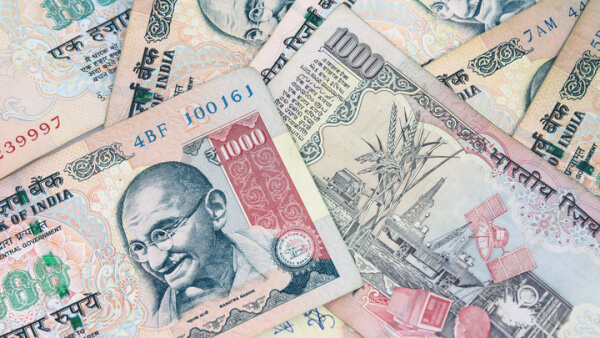Taking cash in or out of India: What are the rules?
How much cash can you take to India? Read this handy guide for info on the rules for taking cash in and out of India.

If you’re travelling to India on holiday, you can’t get cash ahead of time.
Indian law doesn’t allow foreigners to bring Indian currency into the country, unless they’re residents who have been away on a short trip. So you’ll need to wait until you’ve landed to buy Rupees.
ATMs aren’t as plentiful as they're in some other countries. However, you’ll definitely find a few you can use to get a good exchange rate, at least in major airports and popular areas.
Read this guide to see where you can find ATMs in India, and what you need to know about using them.
Unfortunately, ATMs in India aren’t evenly distributed. They’re plentiful in major airports, large cities and tourist hotspots. But once you venture to lesser known places and rural areas, finding an ATM can be difficult. You’ll need to think ahead, or risk being left without access to cash.
India’s four largest banks all have convenient online ATM locators. Check ATM locations in your area beforehand and plan accordingly.
Most Indian ATMs accept Cirrus, Maestro and Plus - the most common card networks worldwide. Your bank can confirm the network your card belongs to. Once you’re in India, simply look for your card’s logo on an ATM. Alternatively, use Visa’s online locator (for Plus cards) or MasterCard’s online locator (for Cirrus and Maestro cards).
Don’t forget to inform your bank of the dates you’ll be abroad. If you don’t, your transactions may be considered suspicious and your card will be blocked.
Indian ATMs have some unique characteristics:
While not all Indian banks charge ATM fees, most of them do.
Fees vary, but can be anywhere between INR 150 and INR 300 per transaction. ATMs that charge fees should warn you and give you the option of ending the transaction before you’re charged.
Your home bank will also charge fees - usually an ATM withdrawal fee and a foreign transaction fee. Check with them how much you can expect these fees to amount to.
Never choose to perform transactions in your home currency. If you do, the ATM will use Dynamic Currency Conversion to make up an exchange rate. This is often a bad deal. Withdrawals in Rupees, on the other hand, are worked out at the mid-market rate - the best exchange rate possible.
If you think using an ATM isn’t worthwhile because of the fees, think again. Fees can be avoided, or at least kept to a minimum.
You can avoid paying withdrawal fees if:
1. Your bank is a Global ATM Alliance member
Deutsche Bank, a member of the Global ATM Alliance, has a network of ATMs in India. If you’re an alliance member’s customer, you can use Deutsche Bank ATMs without paying a withdrawal fee.
2. You’re a Citibank customer
Citibank has several branches and ATMs around India. If you’re a Citibank customer in another country, you can use its Indian ATMs for free.
3. You’re an HSBC customer
HSBC operates in India and has a network of ATMs. As an HSBC customer, you can make withdrawals from its Indian ATMs free of charge, but only if you’re an Advance or Premier customer.
Some cards have low foreign transaction fees, making them cheaper to use abroad. Check your bank’s fee schedule, so you’ll know what charges to expect. If you travel a lot, consider switching to a bank with lower fees or getting a fee-free card.
Avoid using your credit card for ATM withdrawals. The transaction is considered a loan; and attracts fees and interest.
If you have an Indian bank account, or know someone who does, use Wise to make the transfer ahead of time and save even more. Not only does Wise use the real mid-market exchange rates to convert your money (which almost always beats the banks), but since your currency is received and sent via local banking systems in both your home country and in India, all those nasty international fees magically disappear. Give it a try.
*Please see terms of use and product availability for your region or visit Wise fees and pricing for the most up to date pricing and fee information.
This publication is provided for general information purposes and does not constitute legal, tax or other professional advice from Wise Payments Limited or its subsidiaries and its affiliates, and it is not intended as a substitute for obtaining advice from a financial advisor or any other professional.
We make no representations, warranties or guarantees, whether expressed or implied, that the content in the publication is accurate, complete or up to date.

How much cash can you take to India? Read this handy guide for info on the rules for taking cash in and out of India.

Read our helpful guide to money, banks and currency in India, plus info on cards and currency exchange.

How to travel to India from the UK, including the type of visa you need, how you can apply, how much it costs, and the best way to exchange money.

Travelling to the USA? Read our roundup of the best UK credit cards to use in the USA, comparing interest rates, fees and more.

Travelling to India? Read our roundup of the best UK credit cards to use in India, comparing interest rates, fees and more.

Read our guide on the best travel card for India, including card comparisons and travel tips.